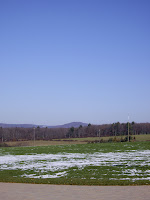When it comes to songs, some places seem to lend themselves more to clichés than others, one of those being Paris, which perhaps has one of the most stereotyped images of capital cities. Romance, cafes, springtime, accordions – all images easy to reach for.
Sometimes, however, those songs can touch an unexpected chord. One of these was Abba’s Our Last Summer, later adapted for the film Mamma Mia. It shouldn’t work. On paper the lyrics sound like Bjorn and Benny got a guidebook to Paris and started ticking off all the things that should be mentioned - the Seine, the Eiffel Tower, the Notre Dame, the Elysee, the Mona Lisa, no regrets. Even ‘croissant’ got in by virtue of rhyming it with ‘restaurant’. The original version, however, is more effective than it might first appear. Part of that is the strength of Frida’s singing. However it is also because the gaucheness of the words make it sound like what it actually was-Bjorn’s recollection of a teenage holiday romance in Paris. Clumsy clichés are what you expect from a lovelorn youngster abroad.
Another such example was Marianne Faithfull’s Paris Bells from 1965, in phase 1 of her career. In the early and mid sixties France, and Paris in particular, cast a bit of a spell on British music and culture. Beatnik culture had drawn heavily on Paris for philosophy, scraggy beards, berets and girls in pale make-up a la Juliette Greco and British folkies and buskers cut their teeth on the streets of Paris. This influence seemed to linger for a while. If you look at clips of Manfred Mann from this time, Manfred Mann himself, with his beard, glasses and polo neck sweaters, looks as if he must have a book on French existentialism propped up on his keyboards.
By 1965, though French pop music may not have travelled well and Johnny Hallyday remained an unknown this side of the channel, some French singers were making a mark in Britain. Francoise Hardy had a top twenty hit that year, as well as being name-checked by Bob Dylan on the cover of his Another Side of Bob Dylan album-‘For francoise hardy at the seine’s edge’. Others-France Gall, Mireille Mathieu, Richard Anthony - followed. The Beatles’ Michelle came out on Rubber Soul, with Paul McCartney remembering the Left Bank influence in his Liverpool Art School days. Paris seemed so more sophisticated, bohemian, cultured, particularly to the young.
In was in this context that Paris Bells was released, in the wake of the success of As Tears Go By. It is a simple fragile song written by Jon Mark, Marianne Faithfull’s regular guitarist, but atmospheric and nostalgic nevertheless with Faithfull’s tremulous soprano voice of that time shimmering over the words. Like the Abba song, it remembers a lost relationship against a sketchy vignette of Paris- dawn over the shuttered houses on the cobbled streets and the barges on the Seine with a backdrop of bells ringing. The traditional and romantic Paris of the 1950’s, the memorable city scenes of the Red Balloon film of 1956.
The song wouldn’t have worked in the hands of many of her contemporaries but her contradictory image then of vulnerable innocence mixed with worldly sophistication fitted the whole mood perfectly. The listener could imagine her escaping to Paris with a head full of philosophy and romantic literature to take up with some Byronic figure with a tortured soul and dark glasses writing poetry in an attic, living on gauloises and espresso and offering a relationship doomed to heroic failure (a Gallic Nick Cave perhaps). It was a side of Paris that many sought, rather like the hippy trail to India and Afghanistan of later years.
Paris, of course, crops up in one of Marianne Faithfull’s later and more well-known songs, her version of Dr Hook’s Ballad of Lucy Jordan and delivered now with a very different singing voice. There, it is as a fantasy that was never going to happen. In real life, Paris did happen for Marianne Faithfull, with an apartment off the rue St Honore, which is probably not like the Paris of either song. Yet any visitor to Paris takes with them the image they want to see: that of Paris Bells remains one to look for.
Link to song








